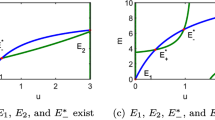Summary
A cellular model, where each individual is explicitly defined, is used to describe a population of a mycophagous species ofDrosophila. Patches represent single fungal fruiting bodies which are only available as oviposition sites for a single fly generation. Standard competition equations are used to describe the interaction between larval genotypes at each patch. Dispersal of adults is obligatory and uses a simple model of patch choice to produce aggregated arrivals of adults at fresh patches. The degree to which aggregation of adults and eggs can promote coexistence of genotypes in a one-locus, two-allele system with dominance is explored. When both phenotypes (A- andaa) are aggregated, a polymorphism can be maintained for over 1000 generations even when the selective disadvantage of one phenotype (aa) is great. This model enhances the degree of polymorphism in a population, using aggregation. It does not preclude the operation of other methods which enhance the coexistence of genotypes. Therefore, it is acting to augment the degree of polymorphism maintained in species which exploit patchy and ephemeral habitats, including allDrosophila and a wide range of other organisms.
Similar content being viewed by others
References
Atkinson, W.D. and Shorrocks, B. (1981) Competition on a divided and ephemeral resource: a simulation model.J. Anim. Ecol. 50, 461–71.
Berger, E. (1976) Heterosis and the maintenance of enzyme polymorphism.Am. Nat.,110, 823–39.
Bishop, J.A. (1972) An experimental study of the cline of industrial melanism inBiston betularia (L.) (Lepidoptera) between urban Liverpool and rural North Wales.J. Anim. Ecol.,41, 209–43.
Christianson, F.B. (1975) Hard and soft selection in a subdivided population.Am. Nat. 109, 11–16.
Clarke, B. (1969) The evidence for apostatic selection.Heredity 24, 347–52.
Clarke, B. (1979) The evolution of genetic diversity.Proc. R. Soc. Lond. [B]205, 453–74.
Clarke, C.A., Mani, G.S. and Wynne, G. (1985) Evolution in reverse: clean air and the peppered moth.Biol. J. Linn. Soc. 26, 189–99.
Comins, H.N., Hassell, M.P. and May, R.M. (1992) The spatial dynamics of host-parasitod systems.J. Anim. Ecol. 61, 735–48.
Dover, G.A. (1986) Molecular drive in multigene families: how biological novelties arise, spread and are assimilated.Trends Genet. 2, 159–65.
Dytham, C. and Shorrocks, B. (1992) Selection, patches and genetic variation: a cellular automaton modellingDrosophila populations.Evol. Ecol. 6, 342–51.
Ellner, S. and Hairston, N.G. (1994) Role of overlapping generations in maintaining genetic variation in a fluctuating environment.Am. Nat. 143, 403–17.
Ermentrout, G.B. and Edelstein—Keshet, L. (1993) Cellular automaton approaches to biological modelling.J. Theoret. Biol. 160, 97–133.
Hassell, M.P. and Comins, H.N. (1976) Discrete time models for two-species competition.Theor. Pop. Biol. 9, 202–21.
Hassell, M.P., Comins, H.N. and May, R.M. (1991) Spatial structure and chaos in insect population dynamics.Nature 353, 255–8.
Hoekstra, R.F., Bijlsma, R. and Dolman, A.J. (1985) Polymorphism from environmental heterogeneity: models are only robust if the heterozygote is close in fitness to the favoured homozygote in each environment.Genet. Res. 45, 299–314.
Howlett, R.J. and Majerus, E.N. (1987) The understanding of industrial melanism in the peppered moth (Biston betularia) (Lepidoptera: Geometridae).Biol. J. Linn. Soc. 30, 31–44.
Ives, A.R. (1988) Covariance, coexistence and the population dynamics of two competitors using a patchy resource.J. Theoret. Biol. 133, 345–61.
Kimura, M. (1983)The Neutral Theory of Molecular Evolution. Cambridge University Press, Cambridge, UK.
Kreitman, M., Shorrocks, B. and Dytham, C. (1992) Genes and ecology: two alternative perspectives usingDrosophila. InGenes in ecology (R.J. Berryet al., eds)BES Symposium Vol.33, pp. 281–312. Blackwell, Oxford, UK.
Li, C.C. (1955) The stability of an equilibrium and the average fitness of a population.Am. Nat. 89, 281–96.
Lloyd, M. (1967) ‘Mean crowding’J. Anim. Ecol. 36, 1–30.
Mani, G.S. (1980) A theoretical study of morph ratio clines with special reference to melanism in moths.Proc. R. Soc. Lond. [B]210, 299–316.
Mani, G.S. (1982) A theoretical analysis of the morph frequency variation in the peppered moth over England and Wales.Biol. J. Linn. Soc. 1, 259–67.
Maynard Smith, J. and Slatkin, M. (1973) The stability of predator—prey systems.Ecology 54, 384–91.
Nevo, E. (1978) Genetic variation in natural populations: patterns and theory.Theoret. Pop. Biol. 13, 121–77.
Nicholson, A.J. (1954) An outline of the population dynamics of natural populations.Aust. J. Zool. 2, 9–65.
Rosewell, J., Shorrocks, B. and Edwards, K. (1990) Competition on a divided and ephemeral resource: testing the assumptions. I. Aggregation.J. Anim. Ecol. 59, 977–1001.
Shorrocks, B. (1982). The breeding sites of temperate woodlandDrosophila. InThe genetics and biology of Drosophila, Vol. 3b, (M. Ashburner, H.L. Carson and J.N. Thompson Jr eds) pp. 385–428. Academic Press, London, UK.
Shorrocks, B. (1990) Competition and selection in a patchy and ephemeral habitat: the implications for insect life-cycles. InInsect life cycles (F. Gilbert ed.) pp. 215–28, Springer-Verlag, London, UK.
Shorrocks, B. and Charlesworth, P. (1980) The distribution and abundance of the British fungal-breedingDrosophila.Ecol. Ent. 5, 61–78.
Shorrocks, B. and Rosewell, J. (1987) Spatial patchiness and community structure: coexistence and guild size of drosophilids on ephemeral resources. InOrganisation of communities: past and present (J.H.R. Gee and P.S. Giller, eds), pp. 29–51. Blackwell, Oxford; UK.
Shorrocks, B., Rosewell, J., Edwards, K. and Atkinson, W.D. (1984) Interspecific competition is not a major organizing force in many insect communities.Nature 310, 310–12.
Taylor, L.R. (1961) Aggregation, variance and the mean.Nature,189, 732–5.
Wallace, B. (1968) Polymorphism, population size, and genetic load. InPopulation biology and evolution (R.C. Lewontin, ed.) pp. 87–108. Syracuse University Press, Syracuse, NY, USA.
Wallace, B. (1975) Hard and soft selection revisited.Evolution 29, 465–73.
Author information
Authors and Affiliations
Rights and permissions
About this article
Cite this article
Dytham, C., Shorrocks, B. Aggregation and the maintenance of genetic diversity: An individual-based cellular model. Evol Ecol 9, 508–519 (1995). https://doi.org/10.1007/BF01237832
Issue Date:
DOI: https://doi.org/10.1007/BF01237832




